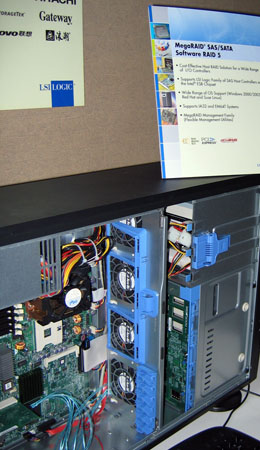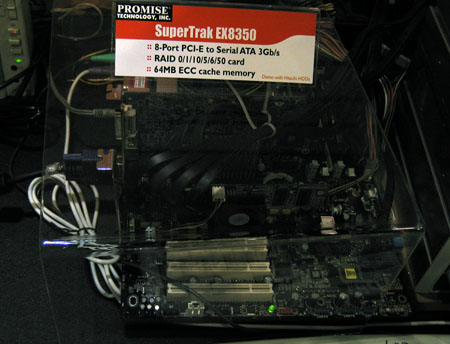Storage
Everyone and everybody couldn’t stop talking about Raid 6 at the show this year. Raid 6, for those not familiar, is a striping technology similar to Raid 5, but considerably more resource and CPU intensive. On the upside, a Raid 6 array can lose as many as two disks before failure, and even the loss of one or two disks will force the array to begin repairing itself in the background. The only downside to this technology, because it is so CPU intensive, is that it only comes in software form. The hardware is still needed to support Raid 6, but a software driver is what actually enables the technology. The other downside is that many disks are needed for Raid 6 to really become viable. Don’t expect to run this on your desktop to increase World of Warcraft performance – this is pretty much server level technology. There were also some new SAS and Infiniband controllers on the show floor at HighPoint, and those are technologies that we will definitely keep an eye on.
LSI
Besides their Raid 6 demonstrations, LSI also had a considerable amount of their suite dedicated to MegaRAID, their SAS and SATA software RAID 5 solution. While BSD operating systems have enjoyed Raid 5 software RAID via the OS for years, Linux and Windows have not been as fortunate. MegaRAID will support 32-bit and 64-bit operating systems.

Click to enlarge.
Promise
Below, you can see a shot of Promise’s Raid 8-port SATA controller with Raid 6 support and 64MB of ECC cache on board.

Click to enlarge.

Click to enlarge.
NetCell
Running from meeting to meeting, we met a very interesting employee from a company called NetCell. While we don’t have exact details at the moment, the NetCell employee mentioned that they were developing a transparent technology that built Raid 3 arrays. Raid 3 works similarly in the manner of Raid 5, but an entire hard disk is devoted to parity instead. Thus, one could lose an entire drive (or the parity drive) and still function fine. The advantage is performance – there are fewer duplicate writes – but a three-disk array only has the capacity of two disks. What NetCell aims to do is make this technology completely transparent to the user. Plugging three drives into the NetCell controller will set up the raid stripe automatically and further configuration is handled by the chip. Since there is no CPU overhead (unlike Raid 6), NetCell might have a pretty interesting technology in the near future – particularly for gamers and enthusiasts.
35 Comments
View All Comments
KristopherKubicki - Friday, June 3, 2005 - link
Thanks for the update DoctorBooze. The details I got were just from a quick conversation with a VP at NetCell. It sounds like their tech is going to be on some motherboards in the near future, so hopefully by then I'll have more details.Kristopher
DoctorBooze - Friday, June 3, 2005 - link
Couple of points about all this RAID stuff. The RAID level described in the article is RAID 4, not RAID 3; RAID 3 uses byte-level striping, not block-level. RAID 3 needs synchronised spindles for adequate performance because, to read a whole block back, you have to read off all the discs except the parity disc. Most implementations will also read back the parity and make sure the data is valid; there's no performance hit for this. Overall, RAID 3 reads and writes about as fast as a single drive (whether you have validation enabled or not). It's a very safe way to store your data, as it'll pick up single-sector faults and correct for them (and the controller or OS can subsequently mark the block as bad with no harm done).RAID 4 and RAID 5 do not require synchronised spindles because they operate at a block level, so for any block of data you only have to read one disc, and if they validated the data, they'd be as slow as RAID 3 (because they'd have to read the contents of all the discs to retrieve and validate one block, which would mean you got none of the benefits of parallelism). RAID 4 and 5 only protect against faulty sectors if the drives report them as faulty rather than just returning duff data.
KristopherKubicki - Friday, June 3, 2005 - link
Re: All the comments about RAID5 - I may be a little biased, but the cannotation was *good* RAID5 support in kernel!Kristopher
KristopherKubicki - Friday, June 3, 2005 - link
JHutch: RAID3 is pretty much identical to RAID5 except that RAID3 dedicates a whole disk to parity.RyanVM: I might have phrased it incorrectly - but we meant to say don't expect to see a new card between X550 and R520.
Kristopher
fsardis - Friday, June 3, 2005 - link
is it just me or the new stacker 830 has 9 bays instead of 12? how can it be bigger than the original stacker then as mentioned in the article?LidlessEye - Friday, June 3, 2005 - link
Rebuild time shouldn't be quite that long... depending on other I/O and the RAID controller, I'm sure. But if there's a lot of I/O, you shouldn't be using ATA anyway... the probability of a failure even if it takes a day is miniscule. Also, since it wasn't pointed out in the article, RAID 10 or 0+1 offers much greater I/O and nearly the same fault tolerance for four disks, I would use 0+1 at 6 disks (instead of five in RAID 6). So that leaves RAID 6 for 7 or more drives... 14 is often cited as a "common" configuration. FWIW, EMC and IBM recommend RAID 10 and 5 in most of their SAN gear.USAF1 - Thursday, June 2, 2005 - link
@#25The other issue with RAID-3 is that all disks in the array are spindle synchronized. So, your I/O's per second are also limited to that of a single drive. By contrast, RAID-5 allows for independent control of all hard drives in the array. RAID-3 is great for streaming large, contiguous files but not much else. I have 18TB of CIPRICO RAID-3 devices where I work and I wish I didn't...
Doormat - Thursday, June 2, 2005 - link
Its coz rebuild time on a 10k or 15k 73GB SCSI HD is not that long. On an 8 drive 7200RPM 400GB(per drive) array, rebuild times are on the order of days.LidlessEye - Thursday, June 2, 2005 - link
oh... also, very few people use it in the server world since it so slow, and array failure due to two drive failures is generally caused by negligence, not rebuild time. I would never want to use it for a small array (<7 disks).LidlessEye - Thursday, June 2, 2005 - link
Windows has offered software RAID 5 since at least NT4. So it’s been available for about a decade…RAID 6 is worthless except in very large array sets (like 14 drives) for data archival mainly. Compaq (now HP) has offered this (Called RAID ADG) for about 5 years on their SCSI RAID controllers, and of course that’s in hardware. I believe IBM has offered it for a few years as well.